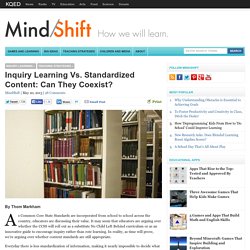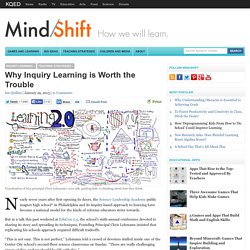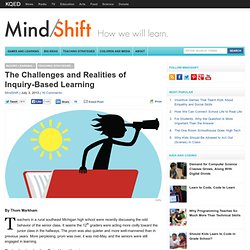

Creating Classrooms We Need: 8 Ways Into Inquiry Learning. If kids can access information from sources other than school, and if school is no longer the only place where information lives, what, then happens to the role of this institution?

“Our whole reason for showing up for school has changed, but infrastructure has stayed behind,” said Diana Laufenberg, who taught history at the progressive public school Science Leadership Academy for many years. Laufenberg provided some insight into how she guided students to find their own learning paths at school, and enumerated some of these ideas at SXSWEdu last week. 1. Inquiry Learning Vs. Standardized Content: Can They Coexist? By Thom Markham As Common Core State Standards are incorporated from school to school across the country, educators are discussing their value.

It may seem that educators are arguing over whether the CCSS will roll out as a substitute No Child Left Behind curriculum or as an innovative guide to encourage inquiry rather than rote learning. In reality, as time will prove, we’re arguing over whether content standards are still appropriate. Everyday there is less standardization of information, making it nearly impossible to decide what a tenth-grader should know.
Beyond the core literacies of reading, writing, computation, and research, the world-wide culture of innovation, discovery, multi-polarity, interdisciplinary thinking, and rapid change depends on the explosive potential of the human mind, not entombed truths from the past. There is only one resolution to the debate. So how can you, as a teacher, help move the dialogue forward? But PBL is the near-term solution. REDEFINE RIGOR. Why Inquiry Learning is Worth the Trouble. Visualization of SLA principal Chris Lehmann's 2011 talk: guiding kids' to thinking about how they think.

Nearly seven years after first opening its doors, the Science Leadership Academy public magnet high school* in Philadelphia and its inquiry-based approach to learning have become a national model for the kinds of reforms educators strive towards. But in a talk this past weekend at EduCon 2.5, the school’s sixth-annual conference devoted to sharing its story and spreading its techniques, Founding Principal Chris Lehmann insisted that replicating his schools approach required difficult tradeoffs. “This is not easy.
This is not perfect,” Lehmann told a crowd of devotees stuffed inside one of the Center City school’s second-floor science classrooms on Sunday. “There are really challenging pieces of this, and we should be OK with this.” “Inquiry means living in the soup. “To me it comes down to process,” Lehmann said. “Oh God, yeah,” Lehmann said in response to the latter teacher. Related. - Create a Culture of Questioning and Inquiry. 4 Comments August 14, 2013 By: Guest Blogger Nancy White Aug 13 Written by: 8/13/2013 6:00 PM ShareThis I have often suggested to teachers that when students have access to technology, whether it is provided by the school in a 1:1, BYOD, or simply the smart phone in their pocket, there should never be a question that goes unanswered –or un-followed.

What I discovered in the 300+ observations I have done for our 21st Century Learning grant work was that the problem isn’t necessarily about allowing time for students to answer questions. As the new school year begins, think about how you might begin to shift from a culture of compliance, to a culture of questioning in your classroom. The Challenges and Realities of Inquiry-Based Learning. Inquiry Learning Teaching Strategies Getty By Thom Markham Teachers in a rural southeast Michigan high school were recently discussing the odd behavior of the senior class.

It seems the 12th graders were acting more civilly toward the junior class in the hallways. The prom was also quieter and more well-mannered than in previous years. The teachers’ explanation: Project-based learning. Here’s the back story. Stories like this are about to become more important to educators. This is a steep challenge because it forces education to cross a philosophic divide. Standardizing Valuable Skills To put a new system in place, a first key step is to disseminate and train every teacher on a clear set of performance standards to assess skills required for effective inquiry, such as communication, collaboration, critical thinking, and creativity. The challenge: Right now, a standards-based environment forces teachers to straddle the inquiry process.
Inquiry Learning Vs. Standardized Content: Can They Coexist? Teaching as inquiry / Inquiry / Case studies / Curriculum stories / The New Zealand Curriculum Online - NZ Curriculum Online. Overview | The focusing inquiry | The teaching inquiry | The learning inquiry | References If you cannot view or read this diagram select this link to open a text version >> Overview The New Zealand Curriculum (pages 34–35) and Te Marautanga o Aotearoa (pages 13–16) describe some of the teaching approaches that research shows to have a consistently positive impact on student learning.

However, they stress that there is no formula that will work for every student in every situation.